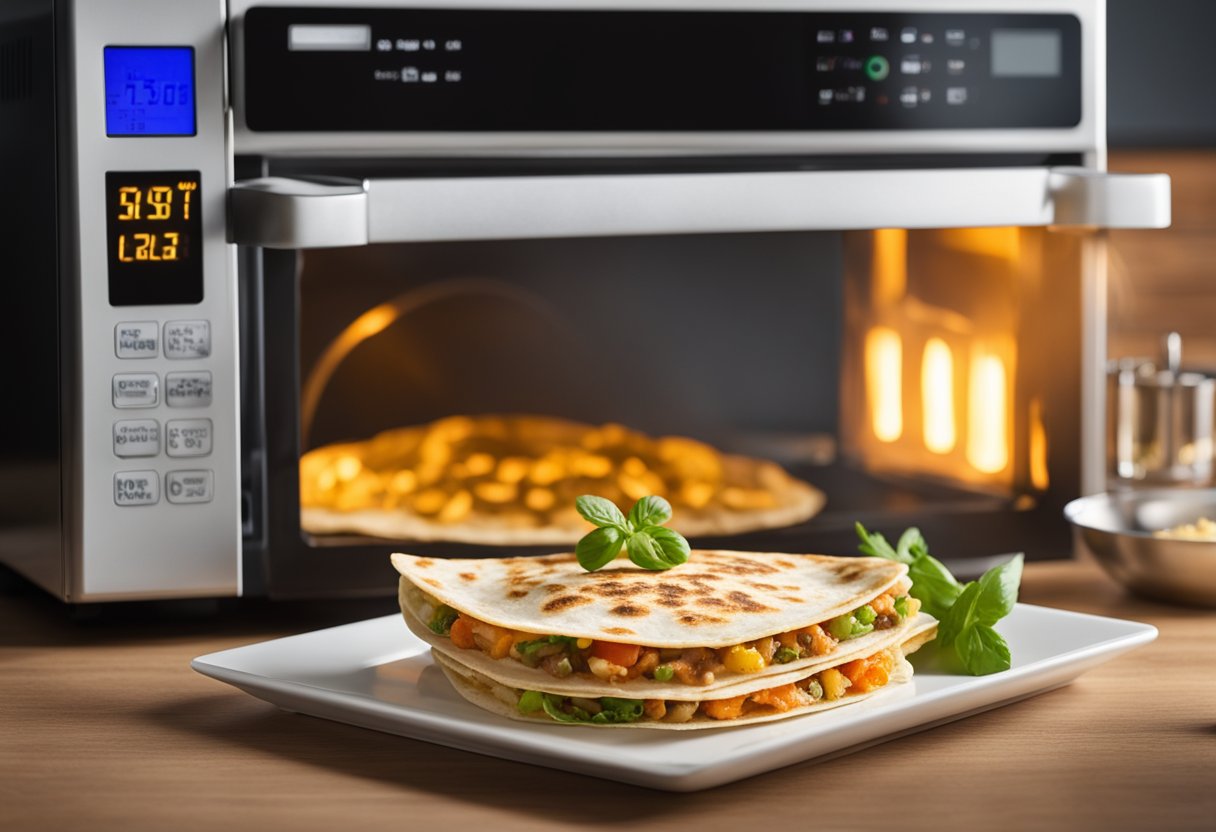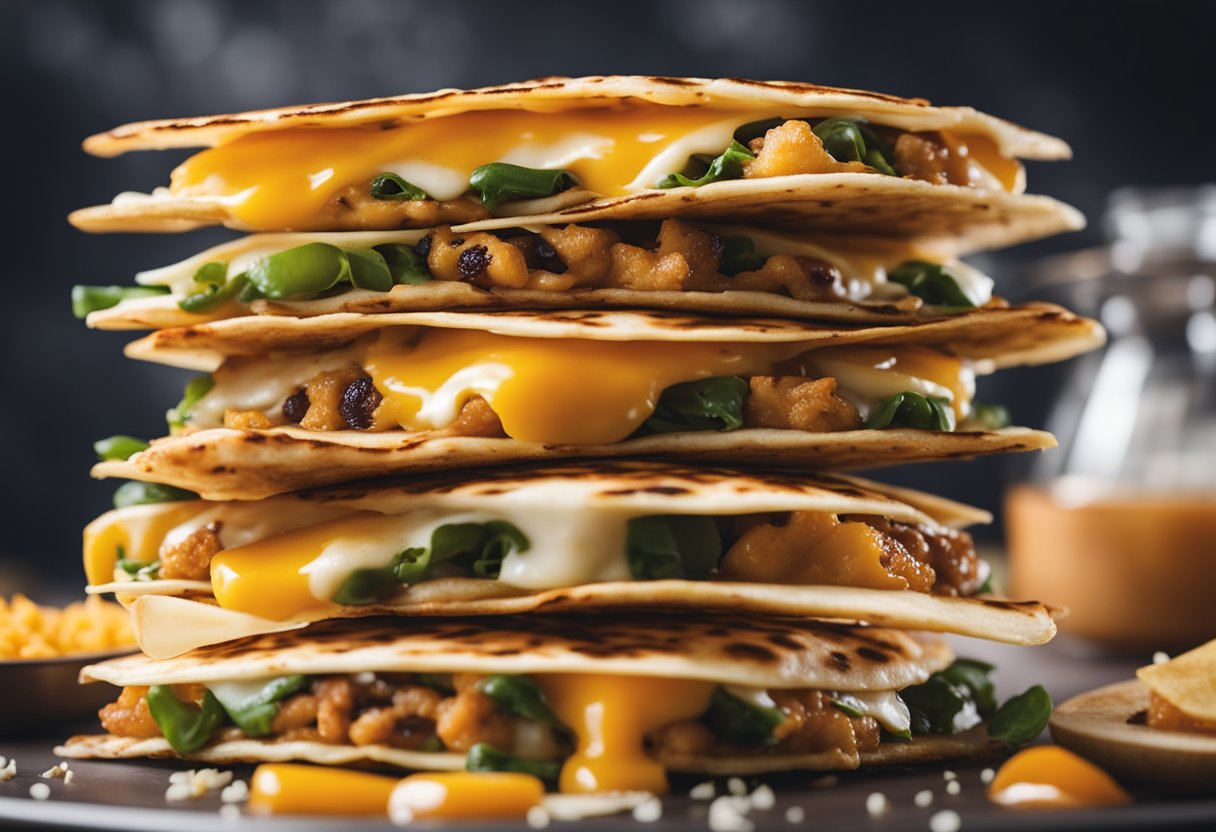I love quesadillas, and I bet you do too! They are a great snack or meal that can be enjoyed anytime. But what happens when you have leftover quesadillas that you want to enjoy again?
Reheating quesadillas can be a bit tricky, but with the right methods, you can enjoy them just as much as when they were first made.

Understanding quesadillas is the first step in reheating them. A quesadilla is a Mexican dish made of a tortilla filled with cheese and other ingredients.
It is typically cooked on a griddle or skillet until the cheese is melted and the tortilla is crispy. When reheating quesadillas, it is important to keep the tortilla crispy and the cheese melted.
Preparation before reheating is also crucial. Before reheating, make sure your quesadilla is properly stored in an airtight container or wrapped in foil. This will help retain moisture and prevent the tortilla from becoming soggy.
Now that you have an understanding of quesadillas and proper preparation, let’s explore the best methods for reheating them.
Key Takeaways
- Understanding quesadillas is important before reheating them.
- Proper preparation before reheating can help retain moisture and prevent the tortilla from becoming soggy.
- The best methods for reheating quesadillas are on the stovetop or in the oven.
Understanding Quesadillas
As someone who loves to cook and eat Mexican food, I can confidently say that quesadillas are one of my favorite dishes.
Quesadillas are a traditional Mexican cuisine made with tortillas and cheese, but you can also add other fillings like chicken, beef, vegetables, or beans.
The main ingredient in quesadillas is cheese, which is usually melted between two tortillas. The tortillas can be made from corn or wheat flour, and they are lightly toasted or fried until crispy.
The cheese used in quesadillas is usually a Mexican cheese like Oaxaca, Chihuahua, or Queso Blanco, but you can also use mozzarella or cheddar cheese.
Chicken quesadillas are a popular variation of this dish. To make chicken quesadillas, you can use cooked and shredded chicken breast, seasoned with Mexican spices like cumin, chili powder, and paprika.
You can also add other ingredients like onions, peppers, or tomatoes to enhance the flavor.
Quesadillas are a versatile dish that can be served as a snack, appetizer, or main course. They are easy to make and perfect for a quick and delicious meal. Quesadillas are also a great way to use up leftover ingredients like cooked chicken or vegetables.
In conclusion, understanding quesadillas is essential to make the perfect reheated quesadilla. Whether you prefer cheese, chicken, or other fillings, quesadillas are a delicious and satisfying dish that everyone can enjoy.
Preparation Before Reheating

Before reheating your quesadillas, it is important to properly store them to ensure they remain fresh and safe to eat.
If you have leftover quesadillas, store them in an airtight container or wrap them tightly with plastic wrap. This will prevent air from getting in and keep them from drying out.
If you plan on storing your leftover quesadillas in the fridge, make sure to label them with the date so you can keep track of how long they have been in there. Leftover quesadillas can be stored in the fridge for up to 3-4 days.
If you want to store your leftover quesadillas for a longer period of time, consider freezing them. To freeze quesadillas, wrap them tightly in plastic wrap or aluminum foil and place them in an airtight container or heavy-duty freezer bags.
Label the container with the date and freeze for up to 2-3 months.
When you are ready to reheat your quesadillas, take them out of the fridge or freezer and let them come to room temperature before reheating. This will ensure that they heat evenly and prevent the tortilla from getting soggy.
By properly storing your leftover quesadillas, you can enjoy them again without compromising their taste or quality.
Reheating Methods
When it comes to reheating quesadillas, there are several methods you can use depending on your preference and the equipment you have available.
Here are some of the most popular methods:
Oven Method
If you want your quesadilla to have a crispy exterior, reheating it in the oven is a great option. Preheat your oven to 350°F and place your quesadilla on a baking sheet lined with aluminum foil.
Bake for 10-15 minutes or until the cheese is melted and the tortilla is crispy.
Stovetop Method
Using a pan or skillet on the stovetop is another great way to reheat a quesadilla. Heat your pan over medium heat and place your quesadilla in the pan. Cook for 2-3 minutes on each side or until the cheese is melted and the tortilla is crispy.
If you want to try the stovetop pizza method, place your quesadilla in a frying pan with a lid over medium heat. Cook for 2-3 minutes or until the cheese is melted. Then, remove the lid and cook for an additional 1-2 minutes or until the tortilla is crispy.
Alternative Methods
If you don’t have an oven or stovetop available, there are still other options for reheating your quesadilla. You can use a toaster oven or air fryer to heat up your quesadilla.
Simply place it in the fryer basket or on a baking tray and heat until the cheese is melted and the tortilla is crispy.
Tips for a Crispy Quesadilla
To ensure that your quesadilla has a crispy exterior, there are a few tips you can follow. First, make sure to reheat it at a high temperature.
This will help to crisp up the tortilla. Additionally, using a wire rack or placing your quesadilla on a tray lined with paper towels can help to keep it crispy.
Preserving and Serving
If you’re reheating quesadillas for a crowd, you can keep them warm by placing them in a container with a lid or covering them with plastic wrap or parchment paper.
You can also place them on a tray and cover them with a damp paper towel or kitchen towel to keep them moist.
When serving your reheated quesadilla, consider adding some fresh toppings like salsa, guacamole, or sour cream to give it some extra flavor. You can also re-fry your quesadilla for a few seconds on each side to give it an extra crispy exterior.
Frequently Asked Questions
What is the best way to reheat a quesadilla?
The best way to reheat a quesadilla is by using an oven or a skillet on the stovetop. Place the quesadilla in the oven at 350°F for 10-12 minutes or on the skillet on low heat for a few minutes on each side until it’s heated through and the cheese is melted.
Avoid using a microwave as it can make the tortilla soggy.
How do you reheat a chicken quesadilla?
To reheat a chicken quesadilla, follow the same method as reheating a regular quesadilla. Place it in the oven or on the stovetop until it’s heated through and the cheese is melted.
If the quesadilla has a lot of chicken, you can also cover it with foil to prevent the chicken from drying out.
Can you reheat a frozen quesadilla?
Yes, you can reheat a frozen quesadilla. The best way to do this is by using an oven. Preheat the oven to 350°F and place the frozen quesadilla on a baking sheet. Bake for 15-20 minutes until it’s heated through and the cheese is melted.
How do you keep quesadillas warm for school lunch?
To keep quesadillas warm for school lunch, wrap them in foil or place them in an insulated lunchbox. You can also heat up a thermos with hot water, pour it out, and then place the quesadilla inside to keep it warm until lunchtime.
What is the best way to reheat a Costco quesadilla?
The best way to reheat a Costco quesadilla is by using an oven or a skillet on the stovetop. Place the quesadilla in the oven at 350°F for 10-12 minutes or on the skillet on low heat for a few minutes on each side until it’s heated through and the cheese is melted.
What are some ideas for using leftover quesadillas?
Leftover quesadillas can be used in a variety of ways. You can chop them up and use them as a topping for salads or soups, or even use them as a filling for breakfast burritos. You can also cut them into strips and use them as a snack with salsa or guacamole.







